Abstract
Based on 2000 census data, ethnic minorities constitute approximately 25% of the overall population of the United States, and the population of minority groups has been increasing at a faster rate than the general U.S. population. Compared with caucasians, persons from minority ethnic groups suffer disproportionately from type 2 diabetes and its long-term complications. Acute complications of diabetes occur with varying frequencies in the different demographic groups, but there are indications that the rate of hospitalization for diabetic ketoacidosis and nonketotic coma may be higher among certain minority populations. Genetic and lifestyle factors likely account for the increased prevalence of type 2 diabetes among ethnic minorities. However, the increase in morbidity and mortality from diabetes may be the result, in part, of socioeconomic factors. Pathophysiologically, several studies have documented a higher prevalence of insulin resistance in minority groups, even after correction for obesity and lifestyle factors. These findings underscore the need for a more aggressive approach to diabetes management in high-risk populations. Behavioral and pharmacologic interventions that reduce insulin resistance have profound beneficial effects in African-American patients and subjects with diabetes from other ethnic groups. Indeed, much of the ethnic difference in morbidity from diabetic complications disappears when caucasians and non-caucasians are treated to identical degrees of glycemic control.
Full text
PDF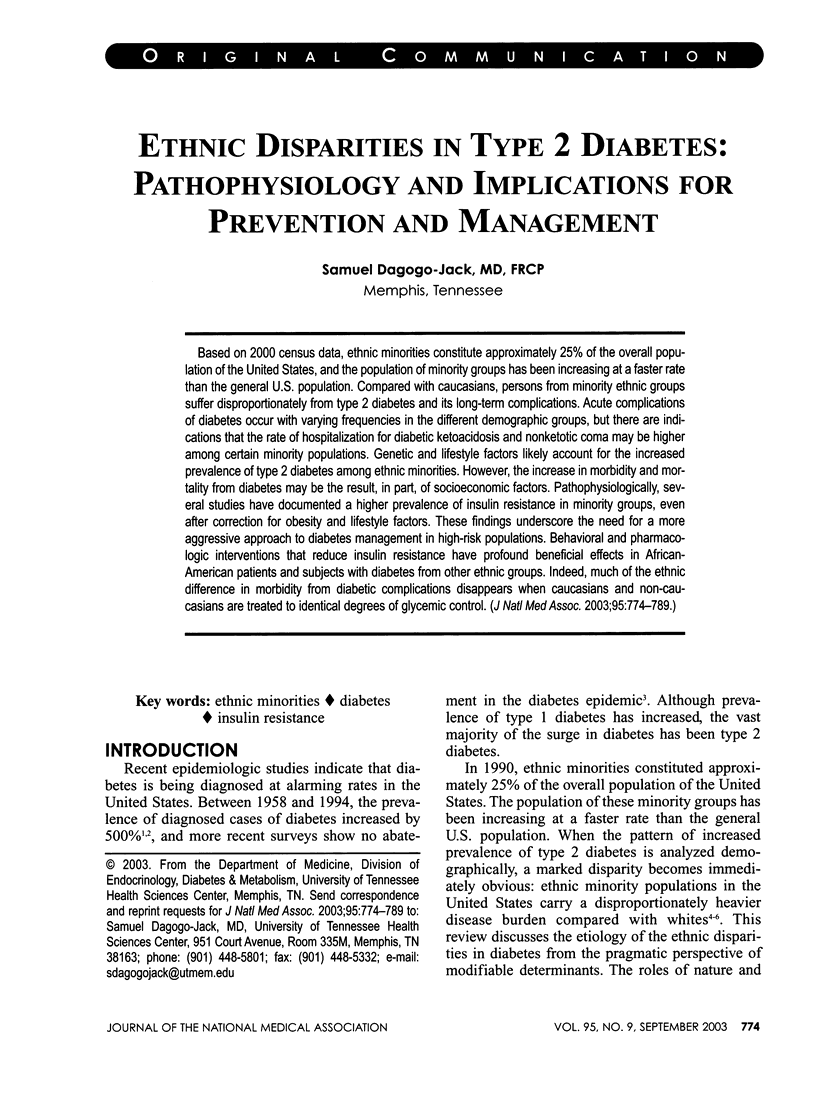
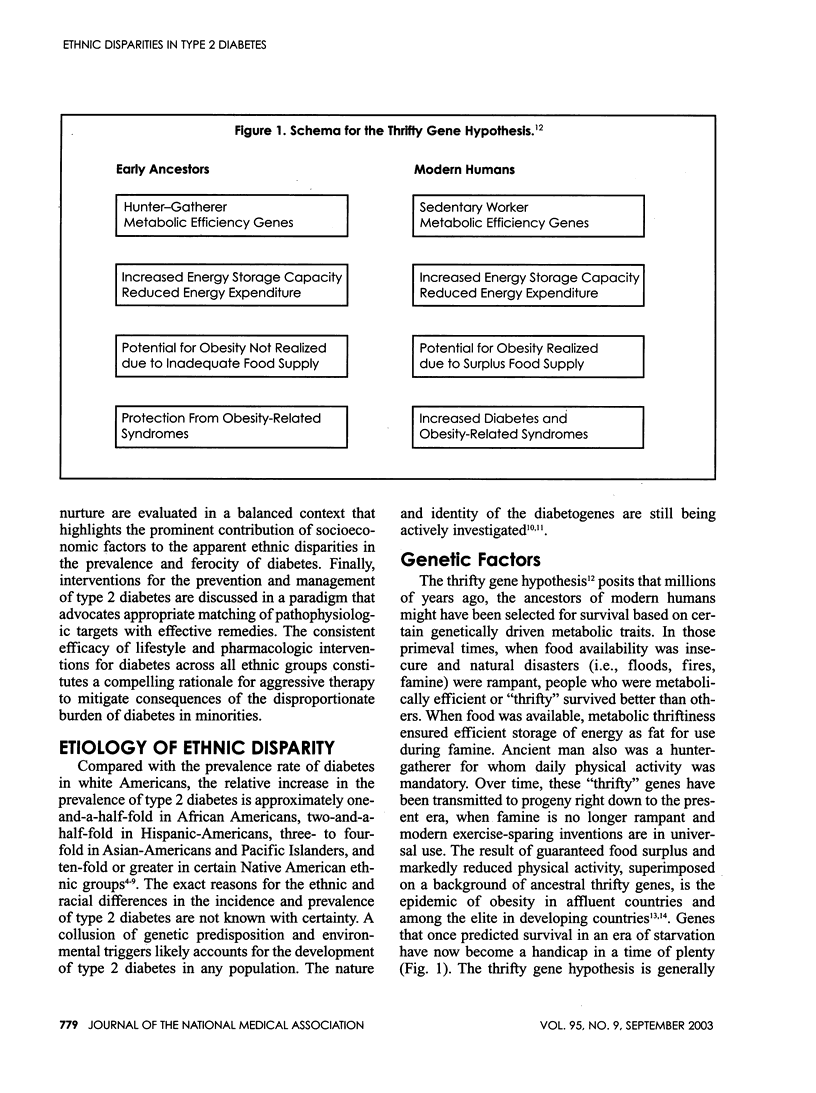
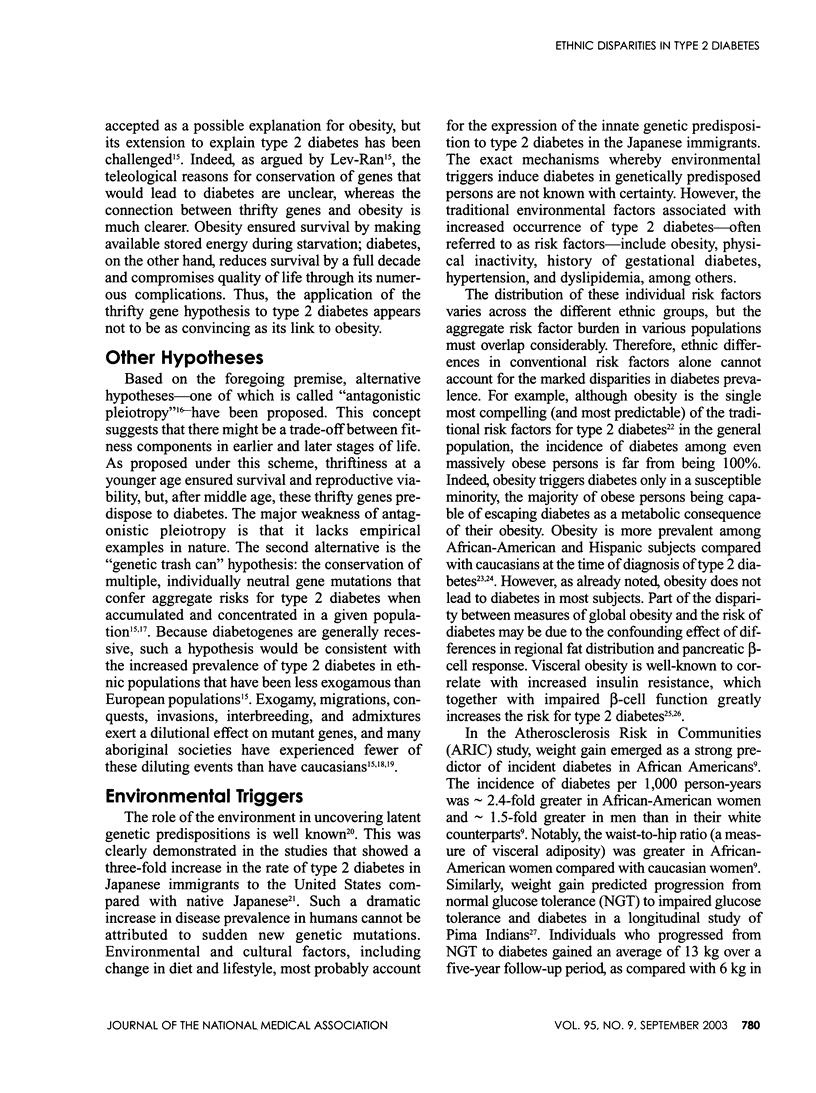
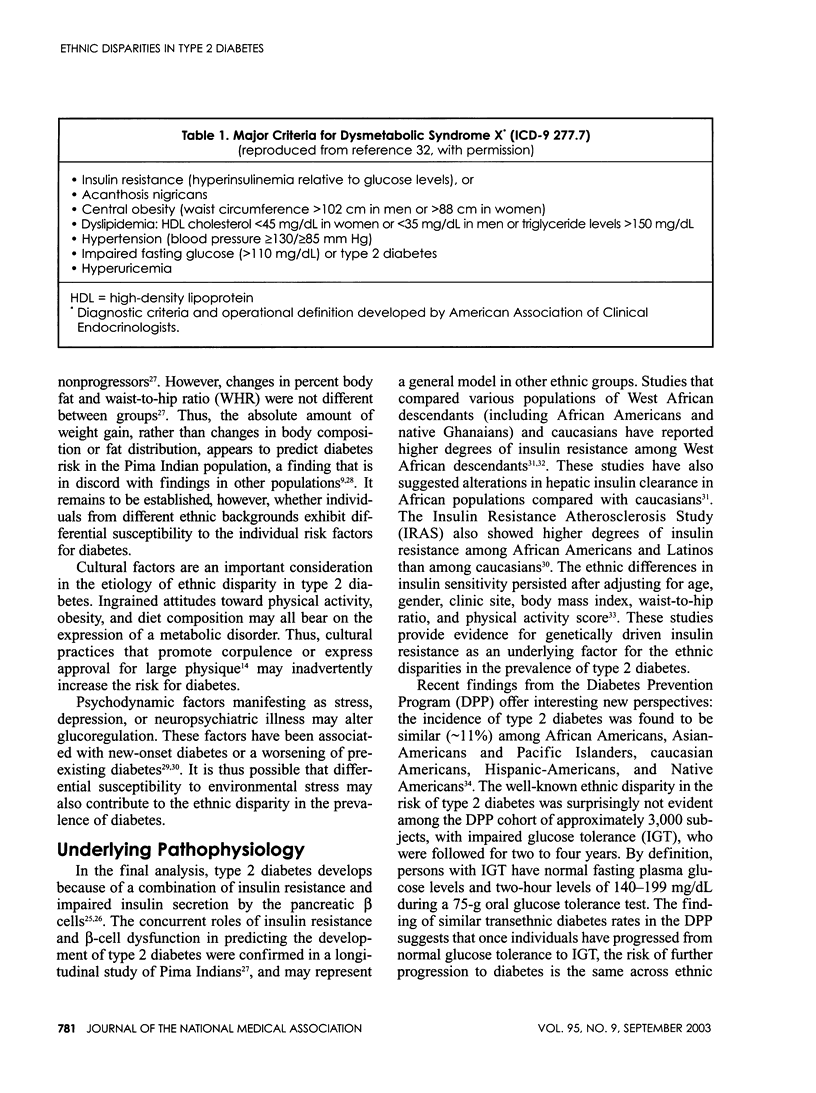
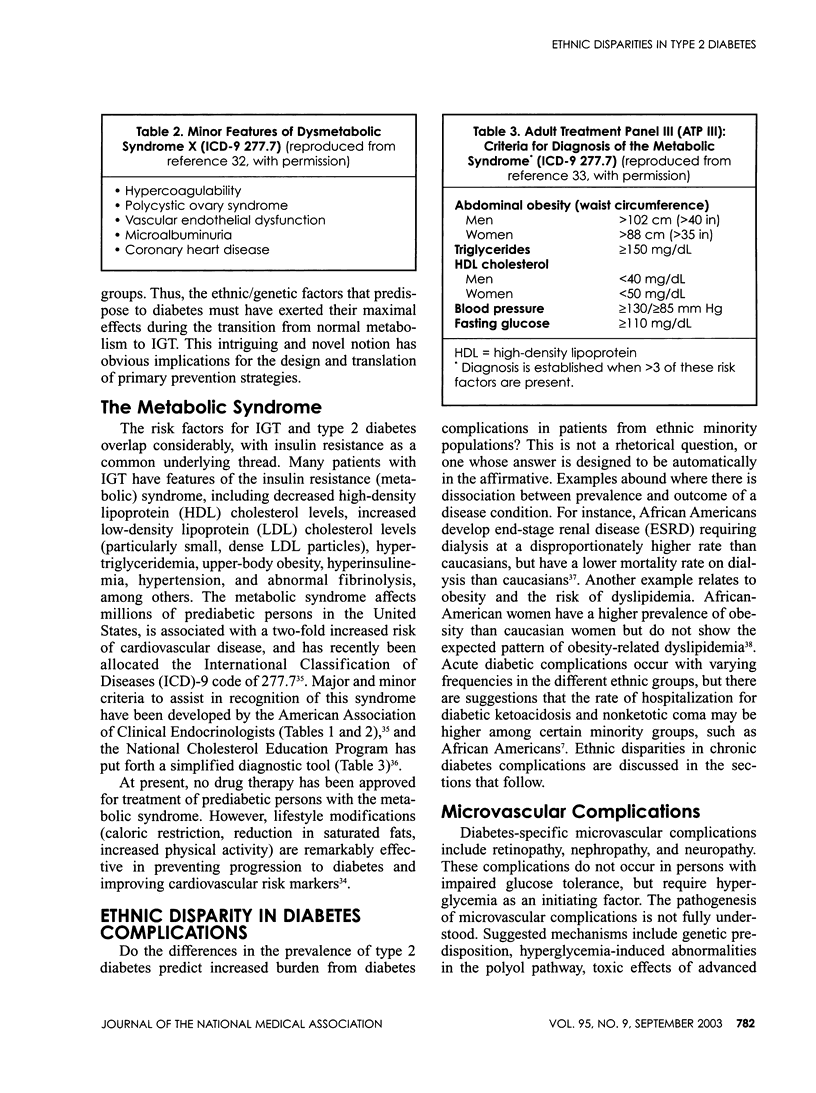
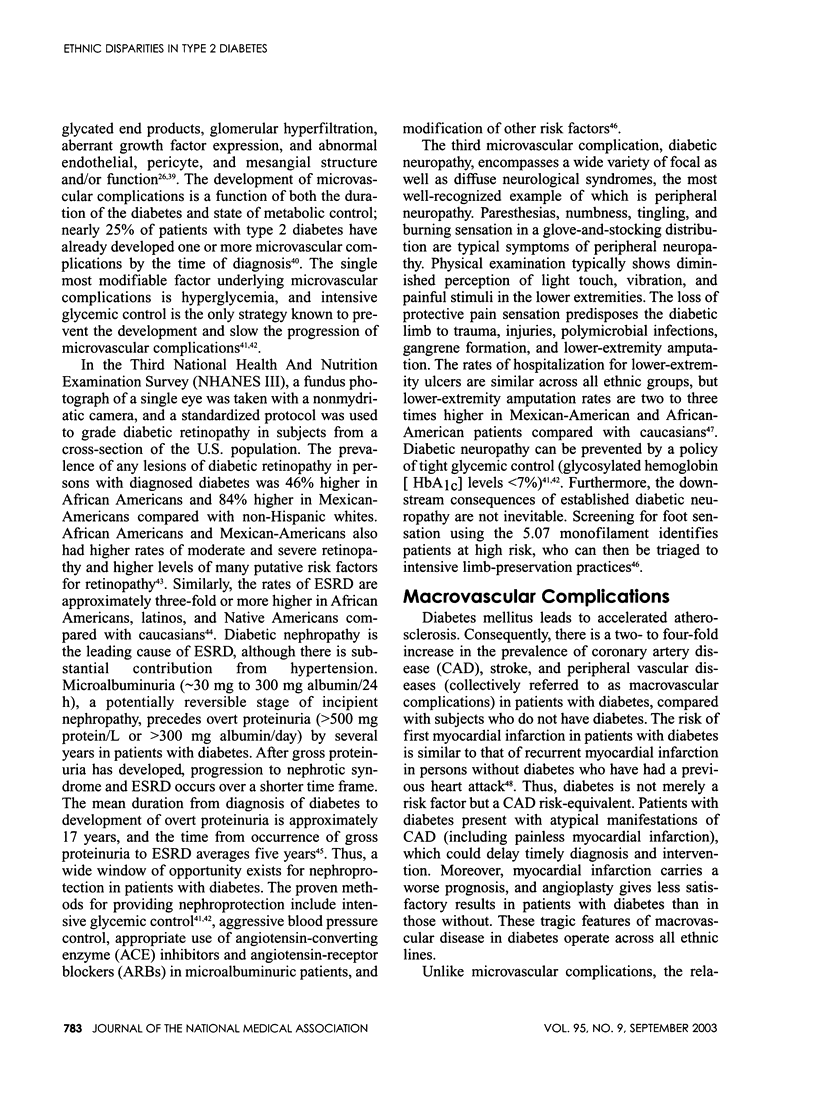
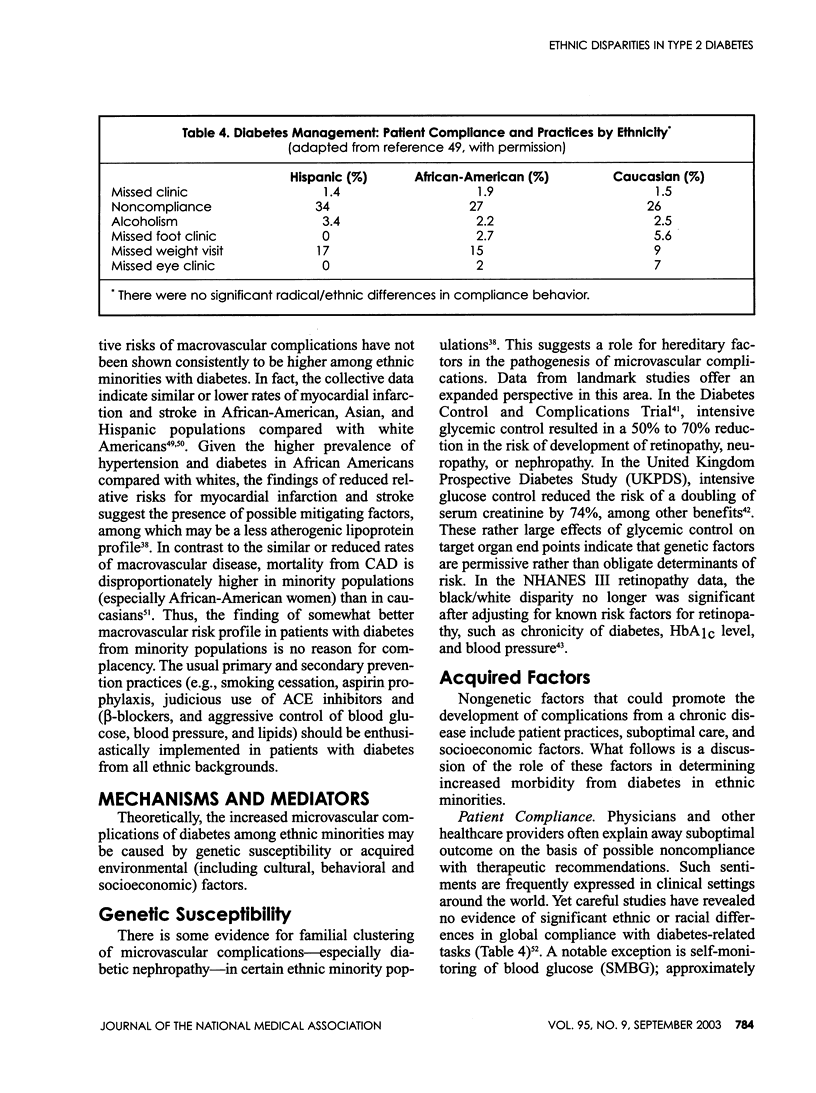
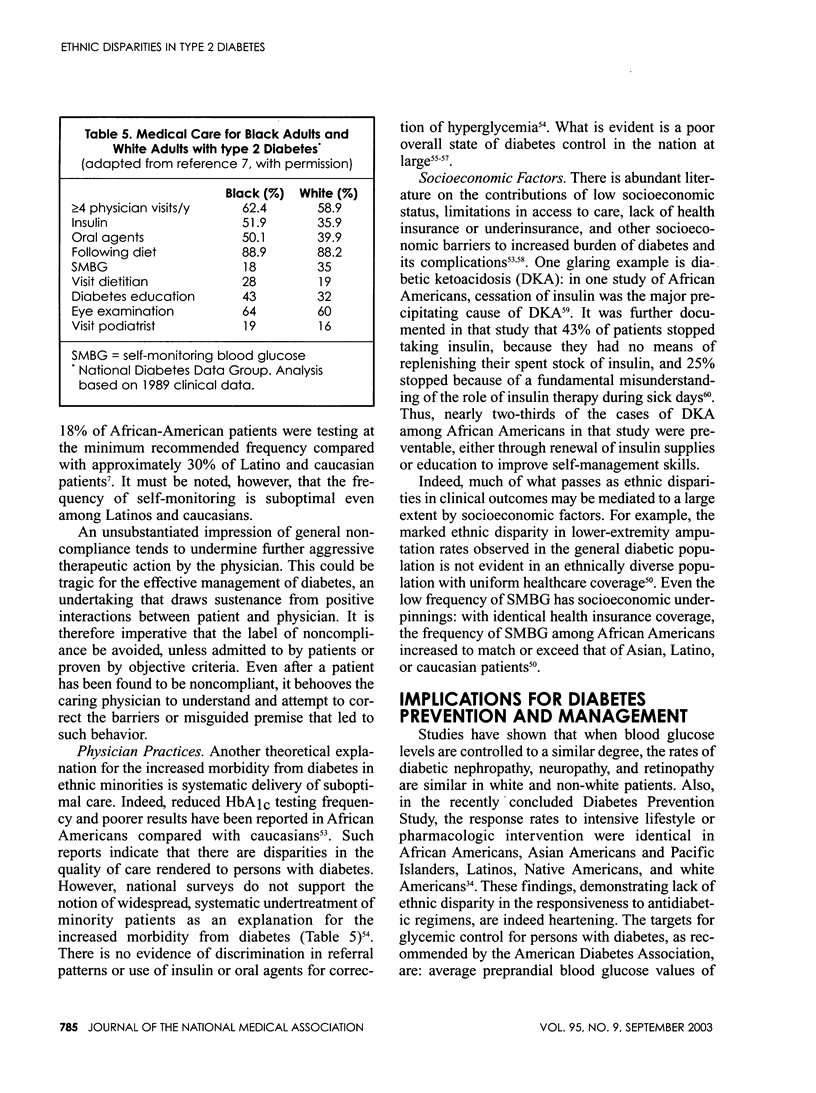
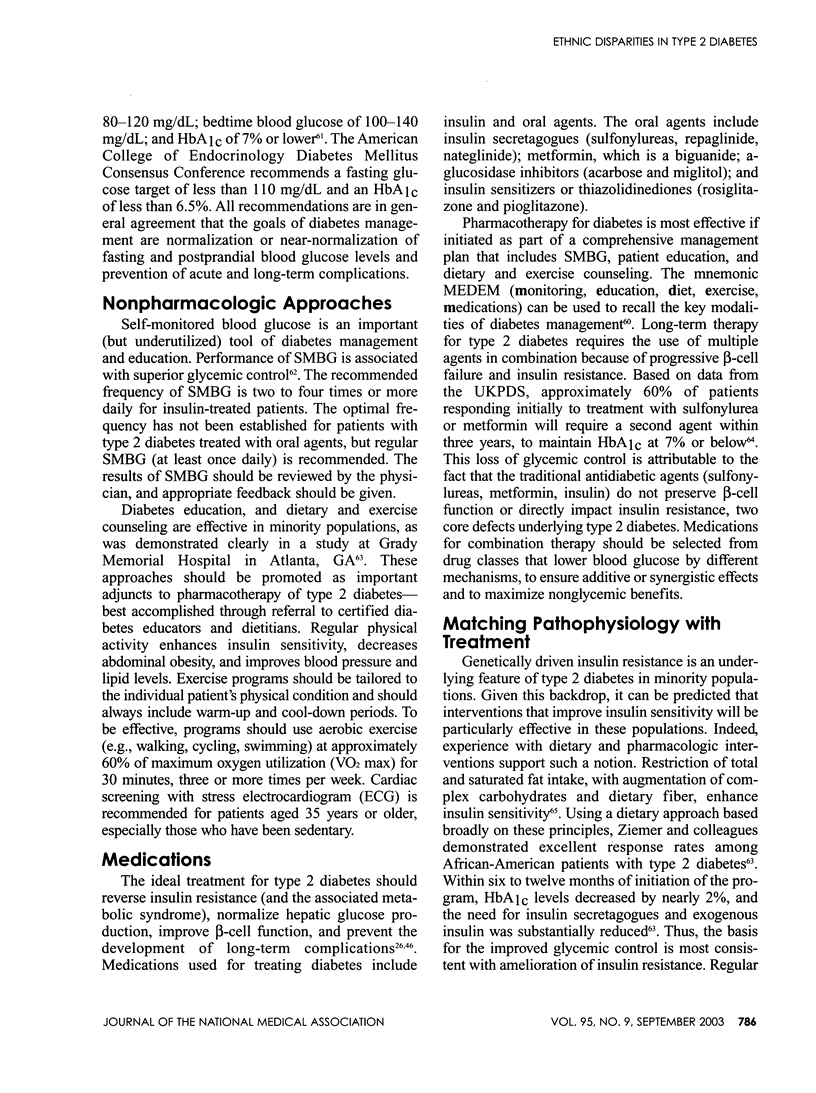
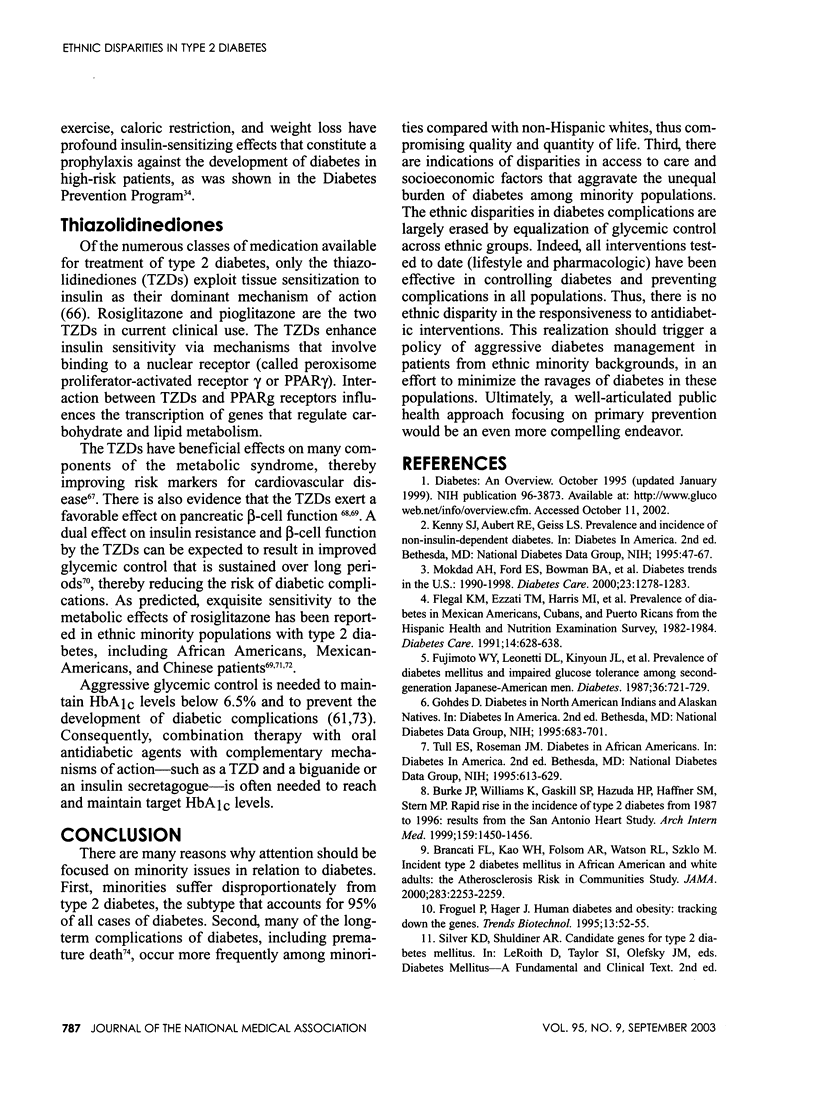
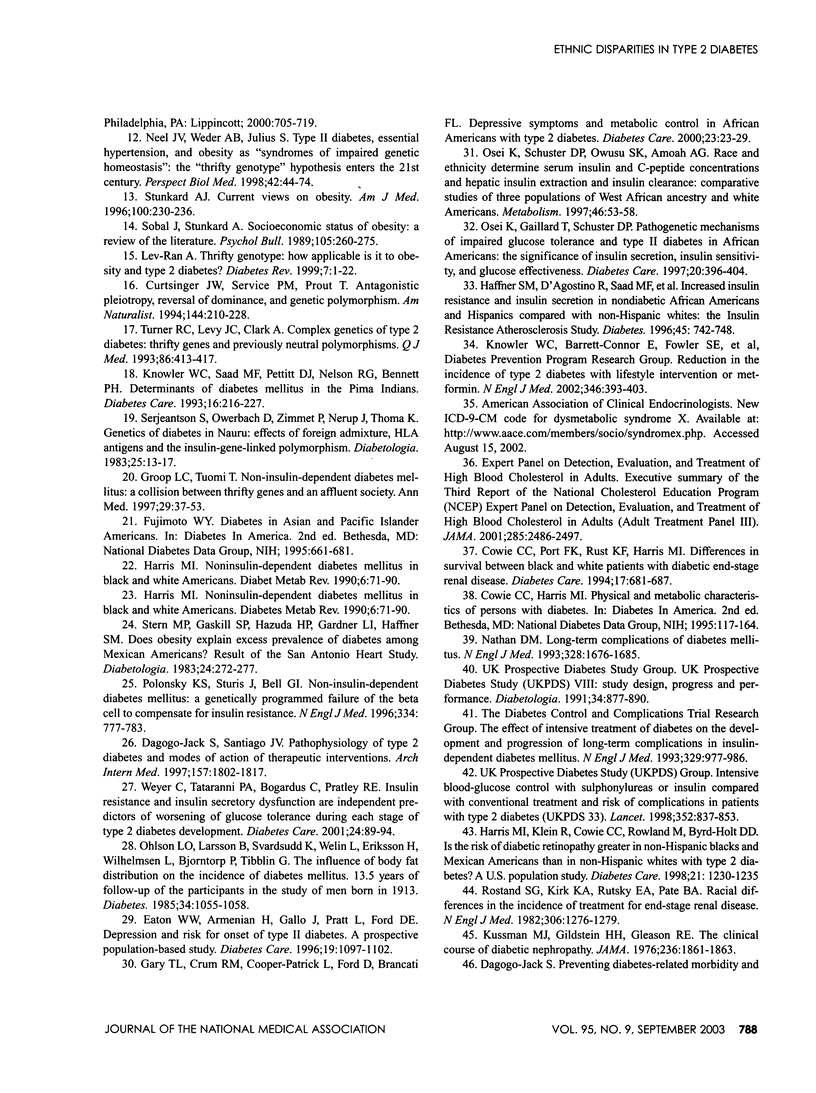
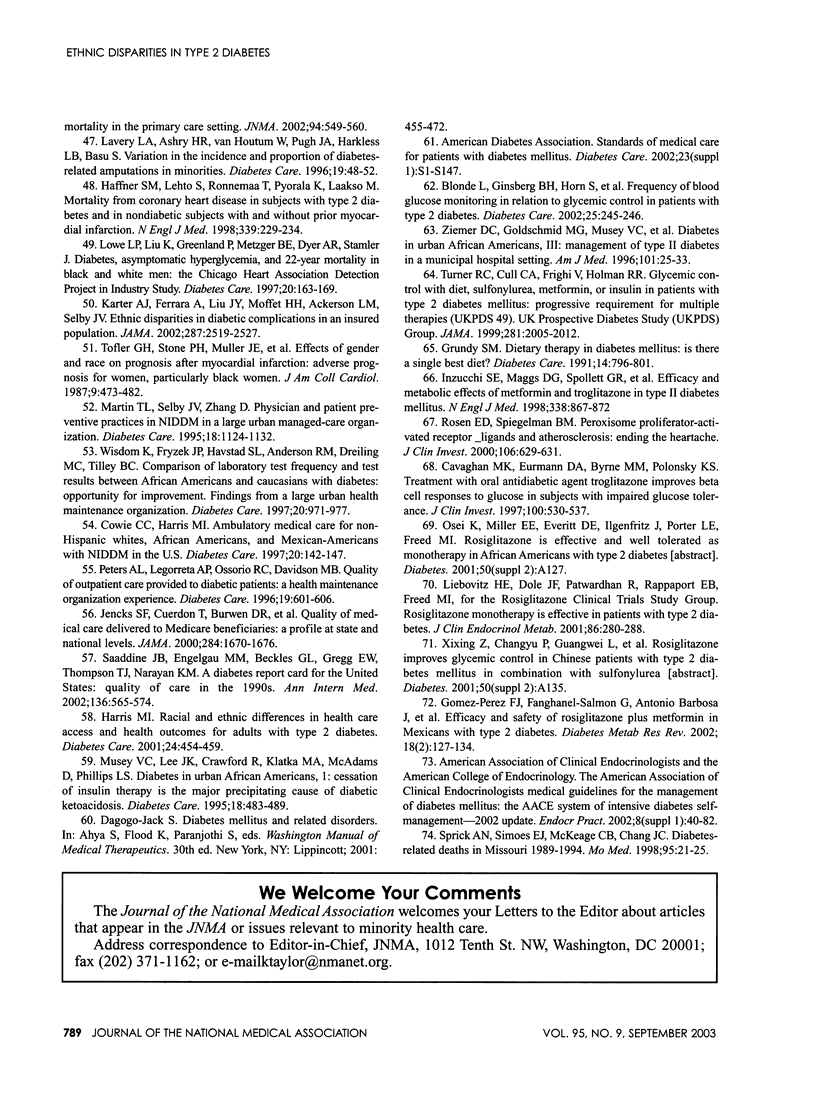
Selected References
These references are in PubMed. This may not be the complete list of references from this article.
- Blonde Lawrence, Ginsberg Barry H., Horn Susan, Hirsch Irl B., James Bobbie, Mulcahy Kathy, Nettles Anne, Smout Randy, Wright Harold. Frequency of blood glucose monitoring in relation to glycemic control in patients with type 2 diabetes. Diabetes Care. 2002 Jan;25(1):245–246. doi: 10.2337/diacare.25.1.245. [DOI] [PubMed] [Google Scholar]
- Brancati F. L., Kao W. H., Folsom A. R., Watson R. L., Szklo M. Incident type 2 diabetes mellitus in African American and white adults: the Atherosclerosis Risk in Communities Study. JAMA. 2000 May 3;283(17):2253–2259. doi: 10.1001/jama.283.17.2253. [DOI] [PubMed] [Google Scholar]
- Burke J. P., Williams K., Gaskill S. P., Hazuda H. P., Haffner S. M., Stern M. P. Rapid rise in the incidence of type 2 diabetes from 1987 to 1996: results from the San Antonio Heart Study. Arch Intern Med. 1999 Jul 12;159(13):1450–1456. doi: 10.1001/archinte.159.13.1450. [DOI] [PubMed] [Google Scholar]
- Cavaghan M. K., Ehrmann D. A., Byrne M. M., Polonsky K. S. Treatment with the oral antidiabetic agent troglitazone improves beta cell responses to glucose in subjects with impaired glucose tolerance. J Clin Invest. 1997 Aug 1;100(3):530–537. doi: 10.1172/JCI119562. [DOI] [PMC free article] [PubMed] [Google Scholar]
- Cowie C. C., Harris M. I. Ambulatory medical care for non-Hispanic whites, African-Americans, and Mexican-Americans with NIDDM in the U.S. Diabetes Care. 1997 Feb;20(2):142–147. doi: 10.2337/diacare.20.2.142. [DOI] [PubMed] [Google Scholar]
- Cowie C. C., Port F. K., Rust K. F., Harris M. I. Differences in survival between black and white patients with diabetic end-stage renal disease. Diabetes Care. 1994 Jul;17(7):681–687. doi: 10.2337/diacare.17.7.681. [DOI] [PubMed] [Google Scholar]
- Dagogo-Jack S., Santiago J. V. Pathophysiology of type 2 diabetes and modes of action of therapeutic interventions. Arch Intern Med. 1997 Sep 8;157(16):1802–1817. [PubMed] [Google Scholar]
- Eaton W. W., Armenian H., Gallo J., Pratt L., Ford D. E. Depression and risk for onset of type II diabetes. A prospective population-based study. Diabetes Care. 1996 Oct;19(10):1097–1102. doi: 10.2337/diacare.19.10.1097. [DOI] [PubMed] [Google Scholar]
- Expert Panel on Detection, Evaluation, and Treatment of High Blood Cholesterol in Adults Executive Summary of The Third Report of The National Cholesterol Education Program (NCEP) Expert Panel on Detection, Evaluation, And Treatment of High Blood Cholesterol In Adults (Adult Treatment Panel III). JAMA. 2001 May 16;285(19):2486–2497. doi: 10.1001/jama.285.19.2486. [DOI] [PubMed] [Google Scholar]
- Flegal K. M., Ezzati T. M., Harris M. I., Haynes S. G., Juarez R. Z., Knowler W. C., Perez-Stable E. J., Stern M. P. Prevalence of diabetes in Mexican Americans, Cubans, and Puerto Ricans from the Hispanic Health and Nutrition Examination Survey, 1982-1984. Diabetes Care. 1991 Jul;14(7):628–638. doi: 10.2337/diacare.14.7.628. [DOI] [PubMed] [Google Scholar]
- Froguel P., Hager J. Human diabetes and obesity: tracking down the genes. Trends Biotechnol. 1995 Feb;13(2):52–55. doi: 10.1016/S0167-7799(00)88905-2. [DOI] [PubMed] [Google Scholar]
- Fujimoto W. Y., Leonetti D. L., Kinyoun J. L., Newell-Morris L., Shuman W. P., Stolov W. C., Wahl P. W. Prevalence of diabetes mellitus and impaired glucose tolerance among second-generation Japanese-American men. Diabetes. 1987 Jun;36(6):721–729. doi: 10.2337/diab.36.6.721. [DOI] [PubMed] [Google Scholar]
- Gary T. L., Crum R. M., Cooper-Patrick L., Ford D., Brancati F. L. Depressive symptoms and metabolic control in African-Americans with type 2 diabetes. Diabetes Care. 2000 Jan;23(1):23–29. doi: 10.2337/diacare.23.1.23. [DOI] [PubMed] [Google Scholar]
- Groop L. C., Tuomi T. Non-insulin-dependent diabetes mellitus--a collision between thrifty genes and an affluent society. Ann Med. 1997 Feb;29(1):37–53. doi: 10.3109/07853899708998742. [DOI] [PubMed] [Google Scholar]
- Grundy S. M. Dietary therapy in diabetes mellitus. Is there a single best diet? Diabetes Care. 1991 Sep;14(9):796–801. doi: 10.2337/diacare.14.9.796. [DOI] [PubMed] [Google Scholar]
- Gómez-Perez Francisco J., Fanghänel-Salmón Guillermo, Antonio Barbosa Juan, Montes-Villarreal Juan, Berry Rhona A., Warsi Ghulam, Gould Errol M. Efficacy and safety of rosiglitazone plus metformin in Mexicans with type 2 diabetes. Diabetes Metab Res Rev. 2002 Mar-Apr;18(2):127–134. doi: 10.1002/dmrr.264. [DOI] [PubMed] [Google Scholar]
- Haffner S. M., D'Agostino R., Saad M. F., Rewers M., Mykkänen L., Selby J., Howard G., Savage P. J., Hamman R. F., Wagenknecht L. E. Increased insulin resistance and insulin secretion in nondiabetic African-Americans and Hispanics compared with non-Hispanic whites. The Insulin Resistance Atherosclerosis Study. Diabetes. 1996 Jun;45(6):742–748. doi: 10.2337/diab.45.6.742. [DOI] [PubMed] [Google Scholar]
- Haffner S. M., Lehto S., Rönnemaa T., Pyörälä K., Laakso M. Mortality from coronary heart disease in subjects with type 2 diabetes and in nondiabetic subjects with and without prior myocardial infarction. N Engl J Med. 1998 Jul 23;339(4):229–234. doi: 10.1056/NEJM199807233390404. [DOI] [PubMed] [Google Scholar]
- Harris M. I., Klein R., Cowie C. C., Rowland M., Byrd-Holt D. D. Is the risk of diabetic retinopathy greater in non-Hispanic blacks and Mexican Americans than in non-Hispanic whites with type 2 diabetes? A U.S. population study. Diabetes Care. 1998 Aug;21(8):1230–1235. doi: 10.2337/diacare.21.8.1230. [DOI] [PubMed] [Google Scholar]
- Harris M. I. Noninsulin-dependent diabetes mellitus in black and white Americans. Diabetes Metab Rev. 1990 Mar;6(2):71–90. doi: 10.1002/dmr.5610060202. [DOI] [PubMed] [Google Scholar]
- Harris M. I. Racial and ethnic differences in health care access and health outcomes for adults with type 2 diabetes. Diabetes Care. 2001 Mar;24(3):454–459. doi: 10.2337/diacare.24.3.454. [DOI] [PubMed] [Google Scholar]
- Inzucchi S. E., Maggs D. G., Spollett G. R., Page S. L., Rife F. S., Walton V., Shulman G. I. Efficacy and metabolic effects of metformin and troglitazone in type II diabetes mellitus. N Engl J Med. 1998 Mar 26;338(13):867–872. doi: 10.1056/NEJM199803263381303. [DOI] [PubMed] [Google Scholar]
- Jencks S. F., Cuerdon T., Burwen D. R., Fleming B., Houck P. M., Kussmaul A. E., Nilasena D. S., Ordin D. L., Arday D. R. Quality of medical care delivered to Medicare beneficiaries: A profile at state and national levels. JAMA. 2000 Oct 4;284(13):1670–1676. doi: 10.1001/jama.284.13.1670. [DOI] [PubMed] [Google Scholar]
- Karter Andrew J., Ferrara Assiamira, Liu Jennifer Y., Moffet Howard H., Ackerson Lynn M., Selby Joe V. Ethnic disparities in diabetic complications in an insured population. JAMA. 2002 May 15;287(19):2519–2527. doi: 10.1001/jama.287.19.2519. [DOI] [PubMed] [Google Scholar]
- Knowler W. C., Saad M. F., Pettitt D. J., Nelson R. G., Bennett P. H. Determinants of diabetes mellitus in the Pima Indians. Diabetes Care. 1993 Jan;16(1):216–227. doi: 10.2337/diacare.16.1.216. [DOI] [PubMed] [Google Scholar]
- Knowler William C., Barrett-Connor Elizabeth, Fowler Sarah E., Hamman Richard F., Lachin John M., Walker Elizabeth A., Nathan David M., Diabetes Prevention Program Research Group Reduction in the incidence of type 2 diabetes with lifestyle intervention or metformin. N Engl J Med. 2002 Feb 7;346(6):393–403. doi: 10.1056/NEJMoa012512. [DOI] [PMC free article] [PubMed] [Google Scholar]
- Kussman M. J., Goldstein H., Gleason R. E. The clinical course of diabetic nephropathy. JAMA. 1976 Oct 18;236(16):1861–1863. [PubMed] [Google Scholar]
- Lavery L. A., Ashry H. R., van Houtum W., Pugh J. A., Harkless L. B., Basu S. Variation in the incidence and proportion of diabetes-related amputations in minorities. Diabetes Care. 1996 Jan;19(1):48–52. doi: 10.2337/diacare.19.1.48. [DOI] [PubMed] [Google Scholar]
- Lebovitz H. E., Dole J. F., Patwardhan R., Rappaport E. B., Freed M. I., Rosiglitazone Clinical Trials Study Group Rosiglitazone monotherapy is effective in patients with type 2 diabetes. J Clin Endocrinol Metab. 2001 Jan;86(1):280–288. doi: 10.1210/jcem.86.1.7157. [DOI] [PubMed] [Google Scholar]
- Lowe L. P., Liu K., Greenland P., Metzger B. E., Dyer A. R., Stamler J. Diabetes, asymptomatic hyperglycemia, and 22-year mortality in black and white men. The Chicago Heart Association Detection Project in Industry Study. Diabetes Care. 1997 Feb;20(2):163–169. doi: 10.2337/diacare.20.2.163. [DOI] [PubMed] [Google Scholar]
- Martin T. L., Selby J. V., Zhang D. Physician and patient prevention practices in NIDDM in a large urban managed-care organization. Diabetes Care. 1995 Aug;18(8):1124–1132. doi: 10.2337/diacare.18.8.1124. [DOI] [PubMed] [Google Scholar]
- Mokdad A. H., Ford E. S., Bowman B. A., Nelson D. E., Engelgau M. M., Vinicor F., Marks J. S. Diabetes trends in the U.S.: 1990-1998. Diabetes Care. 2000 Sep;23(9):1278–1283. doi: 10.2337/diacare.23.9.1278. [DOI] [PubMed] [Google Scholar]
- Musey V. C., Lee J. K., Crawford R., Klatka M. A., McAdams D., Phillips L. S. Diabetes in urban African-Americans. I. Cessation of insulin therapy is the major precipitating cause of diabetic ketoacidosis. Diabetes Care. 1995 Apr;18(4):483–489. doi: 10.2337/diacare.18.4.483. [DOI] [PubMed] [Google Scholar]
- Nathan D. M. Long-term complications of diabetes mellitus. N Engl J Med. 1993 Jun 10;328(23):1676–1685. doi: 10.1056/NEJM199306103282306. [DOI] [PubMed] [Google Scholar]
- Neel J. V., Weder A. B., Julius S. Type II diabetes, essential hypertension, and obesity as "syndromes of impaired genetic homeostasis": the "thrifty genotype" hypothesis enters the 21st century. Perspect Biol Med. 1998 Autumn;42(1):44–74. doi: 10.1353/pbm.1998.0060. [DOI] [PubMed] [Google Scholar]
- Ohlson L. O., Larsson B., Svärdsudd K., Welin L., Eriksson H., Wilhelmsen L., Björntorp P., Tibblin G. The influence of body fat distribution on the incidence of diabetes mellitus. 13.5 years of follow-up of the participants in the study of men born in 1913. Diabetes. 1985 Oct;34(10):1055–1058. doi: 10.2337/diab.34.10.1055. [DOI] [PubMed] [Google Scholar]
- Osei K., Gaillard T., Schuster D. P. Pathogenetic mechanisms of impaired glucose tolerance and type II diabetes in African-Americans. The significance of insulin secretion, insulin sensitivity, and glucose effectiveness. Diabetes Care. 1997 Mar;20(3):396–404. doi: 10.2337/diacare.20.3.396. [DOI] [PubMed] [Google Scholar]
- Osei K., Schuster D. P., Owusu S. K., Amoah A. G. Race and ethnicity determine serum insulin and C-peptide concentrations and hepatic insulin extraction and insulin clearance: comparative studies of three populations of West African ancestry and white Americans. Metabolism. 1997 Jan;46(1):53–58. doi: 10.1016/s0026-0495(97)90167-0. [DOI] [PubMed] [Google Scholar]
- Peters A. L., Legorreta A. P., Ossorio R. C., Davidson M. B. Quality of outpatient care provided to diabetic patients. A health maintenance organization experience. Diabetes Care. 1996 Jun;19(6):601–606. doi: 10.2337/diacare.19.6.601. [DOI] [PubMed] [Google Scholar]
- Polonsky K. S., Sturis J., Bell G. I. Seminars in Medicine of the Beth Israel Hospital, Boston. Non-insulin-dependent diabetes mellitus - a genetically programmed failure of the beta cell to compensate for insulin resistance. N Engl J Med. 1996 Mar 21;334(12):777–783. doi: 10.1056/NEJM199603213341207. [DOI] [PubMed] [Google Scholar]
- Rosen E. D., Spiegelman B. M. Peroxisome proliferator-activated receptor gamma ligands and atherosclerosis: ending the heartache. J Clin Invest. 2000 Sep;106(5):629–631. doi: 10.1172/JCI10909. [DOI] [PMC free article] [PubMed] [Google Scholar]
- Rostand S. G., Kirk K. A., Rutsky E. A., Pate B. A. Racial differences in the incidence of treatment for end-stage renal disease. N Engl J Med. 1982 May 27;306(21):1276–1279. doi: 10.1056/NEJM198205273062106. [DOI] [PubMed] [Google Scholar]
- Saaddine Jinan B., Engelgau Michael M., Beckles Gloria L., Gregg Edward W., Thompson Theodore J., Narayan K. M. Venkat. A diabetes report card for the United States: quality of care in the 1990s. Ann Intern Med. 2002 Apr 16;136(8):565–574. doi: 10.7326/0003-4819-136-8-200204160-00005. [DOI] [PubMed] [Google Scholar]
- Serjeantson S. W., Owerbach D., Zimmet P., Nerup J., Thoma K. Genetics of diabetes in Nauru: effects of foreign admixture, HLA antigens and the insulin-gene-linked polymorphism. Diabetologia. 1983 Jul;25(1):13–17. doi: 10.1007/BF00251889. [DOI] [PubMed] [Google Scholar]
- Sobal J., Stunkard A. J. Socioeconomic status and obesity: a review of the literature. Psychol Bull. 1989 Mar;105(2):260–275. doi: 10.1037/0033-2909.105.2.260. [DOI] [PubMed] [Google Scholar]
- Sprick A. N., Simoes E. J., McKeage C. B., Chang J. C. Diabetes-related deaths in Missouri 1989-1994. Mo Med. 1998 Jan;95(1):21–25. [PubMed] [Google Scholar]
- Stern M. P., Gaskill S. P., Hazuda H. P., Gardner L. I., Haffner S. M. Does obesity explain excess prevalence of diabetes among Mexican Americans? Results of the San Antonio Heart Study. Diabetologia. 1983 Apr;24(4):272–277. doi: 10.1007/BF00282712. [DOI] [PubMed] [Google Scholar]
- Stunkard A. J. Current views on obesity. Am J Med. 1996 Feb;100(2):230–236. doi: 10.1016/s0002-9343(97)89464-8. [DOI] [PubMed] [Google Scholar]
- Tofler G. H., Stone P. H., Muller J. E., Willich S. N., Davis V. G., Poole W. K., Strauss H. W., Willerson J. T., Jaffe A. S., Robertson T. Effects of gender and race on prognosis after myocardial infarction: adverse prognosis for women, particularly black women. J Am Coll Cardiol. 1987 Mar;9(3):473–482. doi: 10.1016/s0735-1097(87)80038-4. [DOI] [PubMed] [Google Scholar]
- Turner R. C., Cull C. A., Frighi V., Holman R. R. Glycemic control with diet, sulfonylurea, metformin, or insulin in patients with type 2 diabetes mellitus: progressive requirement for multiple therapies (UKPDS 49). UK Prospective Diabetes Study (UKPDS) Group. JAMA. 1999 Jun 2;281(21):2005–2012. doi: 10.1001/jama.281.21.2005. [DOI] [PubMed] [Google Scholar]
- Turner R. C., Levy J. C., Clark A. Complex genetics of type 2 diabetes: thrifty genes and previously neutral polymorphisms. Q J Med. 1993 Jul;86(7):413–417. [PubMed] [Google Scholar]
- Weyer C., Tataranni P. A., Bogardus C., Pratley R. E. Insulin resistance and insulin secretory dysfunction are independent predictors of worsening of glucose tolerance during each stage of type 2 diabetes development. Diabetes Care. 2001 Jan;24(1):89–94. doi: 10.2337/diacare.24.1.89. [DOI] [PubMed] [Google Scholar]
- Wisdom K., Fryzek J. P., Havstad S. L., Anderson R. M., Dreiling M. C., Tilley B. C. Comparison of laboratory test frequency and test results between African-Americans and Caucasians with diabetes: opportunity for improvement. Findings from a large urban health maintenance organization. Diabetes Care. 1997 Jun;20(6):971–977. doi: 10.2337/diacare.20.6.971. [DOI] [PubMed] [Google Scholar]
- Ziemer D. C., Goldschmid M. G., Musey V. C., Domin W. S., Thulé P. M., Gallina D. L., Phillips L. S. Diabetes in urban African Americans. III. Management of type II diabetes in a municipal hospital setting. Am J Med. 1996 Jul;101(1):25–33. doi: 10.1016/s0002-9343(96)00071-x. [DOI] [PubMed] [Google Scholar]


